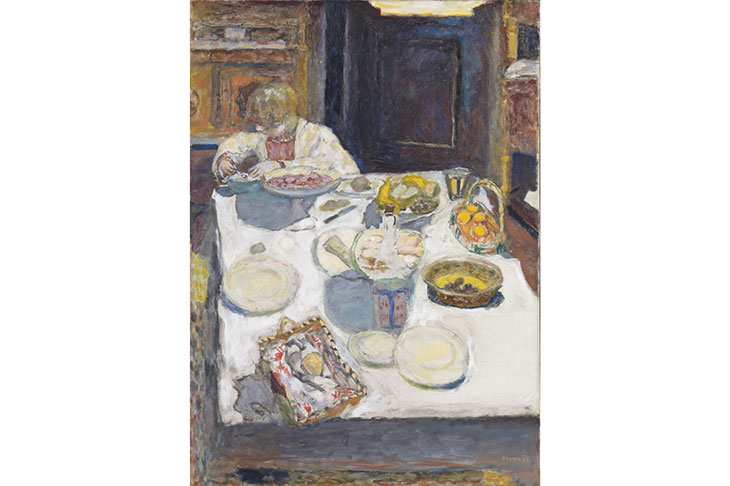An attendant at an art gallery in France once apprehended a little old vandal, or so the story goes. He had smuggled in a palette, paints and brushes under his coat and was trying to alter one of the exhibits — a picture by Pierre Bonnard. On further questioning, it turned out that the elderly vandal was none other than Bonnard himself. Though the work in question had been ‘finished’ years before, he just couldn’t leave it alone.
Bonnard (1867–1947) was a master of indecision, as a glance at just about any picture in Tate Modern’s new exhibition The Colour of Memory reveals. There are no straight lines or clear divisions in his work. Even items you might expect to be sharp —such as window frames — turn out, on closer inspection, to waver. In Bonnard’s world everything is gently woozy. Fittingly, in self-portraits his face is usually in shadow, indistinct and a little blurred, against the light.
Among the unresolved questions that come to mind as you walk around the galleries are ‘How good was Bonnard really?’ And ‘Where does he fit in?’ Neither is easy to answer. Patrick Heron, a leading British abstract artist of the mid-20th century, once told me that in his opinion there were four great painters at work in Paris around 1910: Picasso, Matisse, Braque… and Bonnard. No one nowadays would argue about the first two and few would query the third. But Bonnard? His reputation has imperceptibly faded away.
Yet it’s not hard to see what Heron saw in him — and Francis Bacon (the latter once spent an afternoon talking to Giles Auty, erstwhile art critic of this magazine, and the subject was mainly Bonnard). The common factor between the improbable duo of Bacon and Heron was a fascination with brush strokes.
Heron’s abstractions often took the form of large, soft oblongs of strong but harmonious colour. In other words, they were like a typical Bonnard such as ‘Nude in the Bath’ (1936) or ‘Coffee’ (1915), but with the subjects — naked woman, spaniel, coffee pot, table cloth — taken out. But even in a Bonnard, the people and objects often seem to be in a process of dematerialisation. In ‘Nude in the Bath’, his wife Marthe is a ghostly form beneath the water, while all around the bath tiles and utensils are dissolving into lozenges and spangles of blue and gold.
This gives the clue to where Bonnard came in art historically. He was working on the frontier where representational art was merging into something else. In age, he was an intermediate between the impressionists and early modernists. His paintings sometimes, superficially, look quite like a Monet or Renoir. His themes — views out of the window, French country landscape, naked women, pleasant meals — were much the same.
A Bonnard painting might look as if it had been done at speed and from life. Then you discover that, on the contrary, he was an exponent of slow painting. Sometimes he worried away at a canvas for years and, far from working sur le motif, he was a genuinely Proustian artist. Everything he did was reconstructed, from memory, with — at most — a tiny, fuzzy snapshot as an aide-memoire.
This is where Bonnard’s hazy indecision came in. A memory is much less powerful than visual experience in real time. This process explains some of the oddities of his art. By the standards of a Degas or a Picasso, his drawing was hit and miss. Bonnard’s nudes sometimes have tubular legs and seem to lack skeletal structure. But he wasn’t looking at a model or aiming for naturalism. Decades pass, but the body of his wife Marthe — whose compulsive bathing was one of his constant themes — remained eternally youthful.
Bonnard spent his days chasing elusive recollections: for example, how it looked and felt when sunshine hit a certain yellow bush in ‘Mimosa in the Garden’ (1939–46). Occasionally the result looked visionary. His last picture, ‘Almond Tree in Blossom’ (1946–7), certainly fits that description. But quite often they looked more like a muddle.
This brings us to the second question: how good was Bonnard really? On the evidence of this exhibition, the answer is: extremely uneven. Reluctance to make up his mind played a part in this. Some artists — Bacon was a good example — tightly edit their own output, destroying inferior efforts. Bonnard, it seems, simply sent everything to his dealer in Paris. As a result, there are a lot of unsuccessful works around. In the carefully selected Tate show, the success rate is no more than 50 per cent.
Consequently, as an experience the exhibition isn’t an overwhelming one. But perhaps artists, and everyone, should be judged on their successes rather than their failures. Sometimes he pulled it off — marvellously — transforming a moment of everyday life into billowing clouds of colour.






Comments